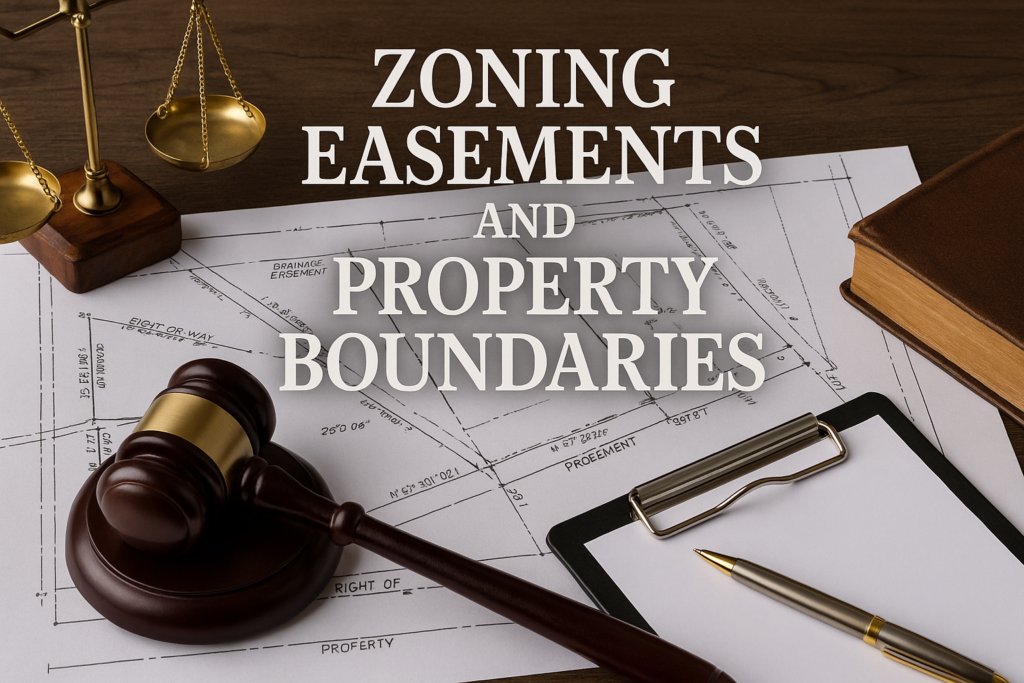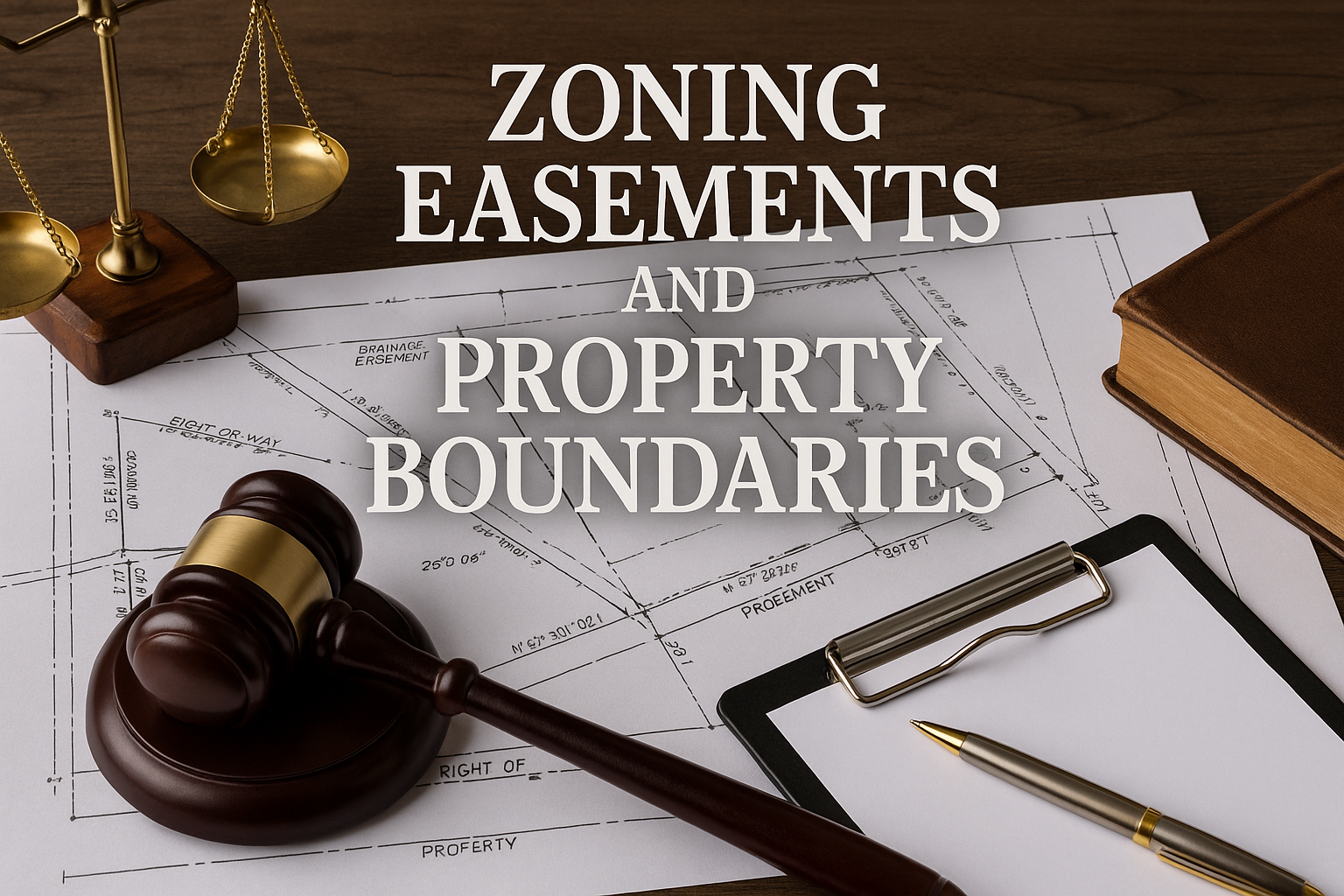Table of Contents
Introduction
Whether you are buying, selling, or developing property, having a clear understanding of the legal rules that dictate how land can be used is critical. Elements such as zoning regulations, the presence of easements, and the exact delineation of property boundaries are foundational aspects that directly impact what you can and cannot do with your land. For anyone involved in Southern California real estate, working with a dedicated Los Angeles real estate law firm can be invaluable when navigating these issues to ensure every aspect of your transaction is compliant and your rights are protected.
The interplay between local zoning ordinances, the creation and enforcement of easements, and the sometimes-complex process of determining property lines makes it essential for property owners to educate themselves on the basics. Lack of awareness in any of these areas can result in costly disputes, development delays, or unforeseen restrictions on land use. By understanding how zoning, easements, and boundary laws interact, you can make more informed decisions and avoid many common real estate headaches.
Understanding Zoning Laws
Local governments utilize zoning as a fundamental and powerful tool to influence and shape the development, layout, and overall makeup of their communities. Zoning ordinances systematically divide cities and counties into designated sections or districts, each with specific prescribed uses, such as residential, commercial, industrial, agricultural, or recreational. These distinctions are not arbitrary; rather, they serve important purposes, including protecting neighborhood character, regulating population density, managing urban growth, and separating potentially conflicting activities. For example, zoning laws help keep heavy industry away from residential neighborhoods and schools to ensure safety and quality of life, while also maintaining a balance between different land uses to promote community well-being and economic vitality.
For any property owner, investor, or prospective buyer, it is of utmost importance to understand not only the current zoning classification of a particular property but also to stay informed about potential future changes. Rezoning initiatives, which are frequently discussed and debated during city council or planning commission meetings, can lead to significant shifts in how a neighborhood is used and developed. These changes can alter the permitted activities on a property, influence property values, and impact what owners are legally allowed to do with their land. Being aware of possible rezoning proposals and understanding the process for approval can help property owners make informed decisions and plan accordingly.
The Role of Easements in Property Use
An easement is a legal right, usually reflected in public records, that allows another individual or entity to use a portion of your property for a specific purpose. The most familiar type, utility easements, gives utility companies the ongoing right to access underground or overhead service lines. Other common easements include:
- Right-of-way easements: Necessary for providing access to a property that would otherwise be landlocked.
- Conservation easements: Designed to preserve natural resources or scenic values, often with permanent restrictions on development.
Easements can be established through a written agreement, arise by necessity (if, for example, no other access to a property exists), or even through long-term, continuous use. When considering a land purchase, always have a legal professional or title company review and explain any recorded easements, as these can substantially impact development potential and long-term value.
Defining Property Boundaries
The importance of accurate boundaries cannot be overstated, as they play a crucial role in defining property rights, resolving disputes, and ensuring legal clarity. Property lines are determined by detailed legal descriptions contained within official deeds, which often reference physical markers such as fences, trees, or survey pins, or rely on historical survey measurements that have been recorded over time. Professional surveys conducted by licensed surveyors are considered the gold standard for clarifying boundaries, as they provide precise measurements and mappings. These surveys not only establish the exact extent of property ownership but also help identify potential issues such as encroachments by neighboring properties, discrepancies or inaccuracies in public records, or conflicts arising from ambiguous boundary descriptions. Accurate boundary determination is essential for property development, legal disputes, and maintaining good neighbor relations, making professional surveying an invaluable tool in real estate and land management.

Why Surveys and Legal Descriptions Matter
Boundary disputes frequently arise due to errors, vague language, or natural changes over time, which can lead to significant misunderstandings between neighbors and property owners. These disputes often cause tension and frustration, disrupting peaceful coexistence in communities. An outdated or inaccurate survey can set the stage for lengthy, expensive legal battles, typically involving court proceedings, substantial legal fees, and strained relationships that may take years to resolve. Therefore, regularly updating your survey, particularly before construction, fencing, or sale, is considered a best practice endorsed by real estate professionals nationwide to help prevent conflicts, safeguard your property rights, and ensure clear boundaries are recognized and respected by all parties involved. Maintaining up-to-date surveys is a proactive approach to avoiding misunderstandings and promoting harmony among neighbors.
Common Boundary Disputes and Resolutions
Neighbor disagreements over property lines can arise from various issues, often involving fences, driveways, landscaping, or even the construction of small buildings or structures. The most common types of disputes include: encroachments, where one property owner has unpermitted structures or features that cross or extend into a neighbor’s property; adverse possession, which in certain circumstances allows a long-term, unopposed use of land by someone who is not the legal owner to result in a legal claim of ownership after a specific period; and ambiguous deed descriptions, where poorly written, unclear, or outdated legal descriptions create confusion, leading to overlapping or conflicting claims of property boundaries. Addressing these issues typically requires obtaining a new, accurate survey of the property and sometimes involves lengthy negotiations between the parties involved. Suppose the parties cannot reach an agreement through negotiation. In that case, judicial resolution in a court of law may be necessary, which underscores the importance of seeking professional legal and surveying consultation at the earliest sign of any dispute to ensure proper handling and to prevent escalation.
Impact of Zoning and Easements on Property Value
Both zoning and easements play a significant role in determining the overall value of a property. Their impact can be substantial, adding or subtracting thousands, and in some cases, even millions of dollars. Strict zoning regulations that limit development potential or restrict certain types of business activities can significantly dampen demand for a property, making it less attractive to prospective buyers. Conversely, rezoning efforts that change the land’s designation for commercial purposes, or other more favorable uses, can often trigger a notable surge in property prices as the land becomes more desirable for investment or development. Similarly, easements, such as conservation easements or rights-of-way, that prohibit access or specific types of development options may noticeably reduce a buyer’s willingness to pay, affecting the overall market value. To navigate these complexities effectively, investors and homeowners must assess these legal encumbrances early in the process. Conducting thorough research through public records, consulting experienced real estate professionals, and understanding local regulations are vital steps to accurately evaluate how these factors might influence land value and make informed investment decisions.
Legal Considerations and Due Diligence
Never finalize a land transaction without conducting a comprehensive and meticulous review of all relevant public records, local zoning ordinances, and any existing written easements. In many cases, resolving potential issues and discrepancies before closing on the property is significantly easier, quicker, and less costly than addressing them after the transaction has been completed. Proper due diligence involves several important steps, including: reviewing all applicable zoning and land use rules to ensure that your intended use of the property is permitted under current regulations; examining all easements, restrictions, and rights-of-way through a detailed title search; commissioning a thorough and accurate land survey by a licensed and experienced surveyor; and consulting with real estate law experts to clarify potential legal risks, liabilities, and to establish an unambiguous ownership record that can stand up to scrutiny.
Conclusion
Being proactive in understanding zoning regulations, easements, and property boundaries is vital for every property owner. These legal principles govern the use, value, and enjoyment of land and are at the heart of countless real estate transactions and disputes. By performing due diligence, seeking expert guidance, and staying informed about local regulations, you can protect your investment and avoid costly surprises down the road. Additionally, having a comprehensive knowledge of these aspects can empower you to make informed decisions, negotiate effectively, and ensure compliance with all relevant laws and ordinances. Regularly consulting with legal professionals, reviewing relevant documentation, and participating in community planning meetings are excellent ways to stay ahead of potential issues and maintain the integrity of your property interests.




